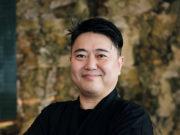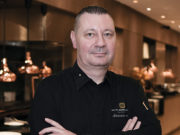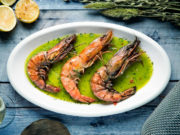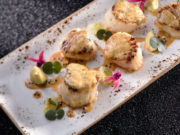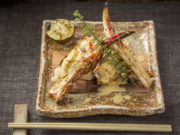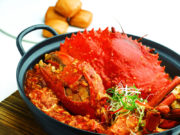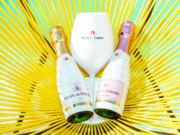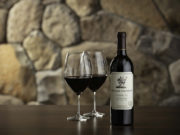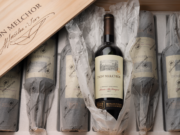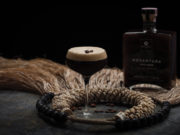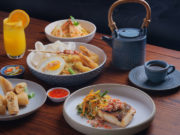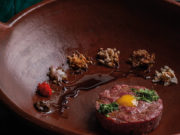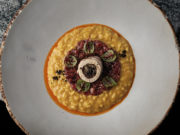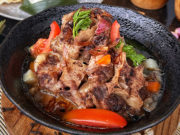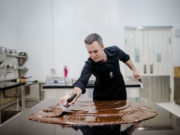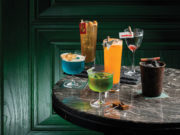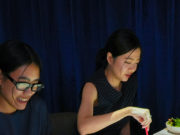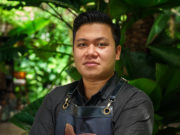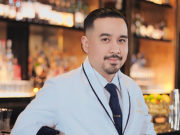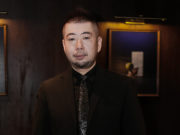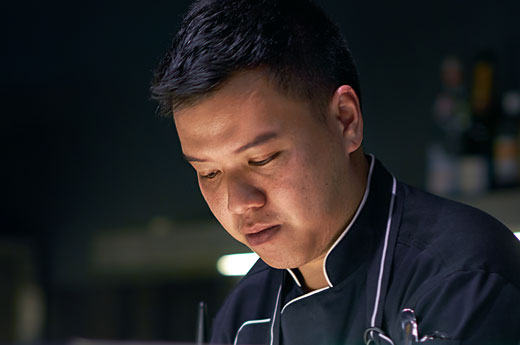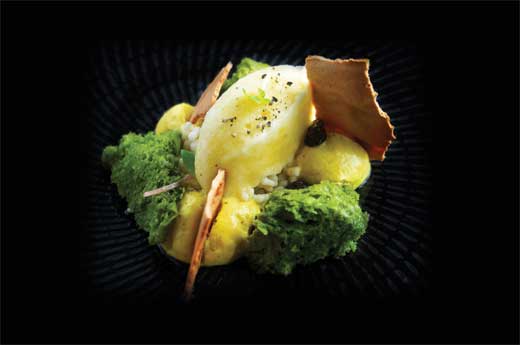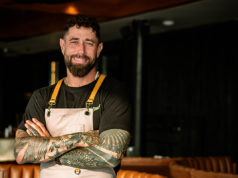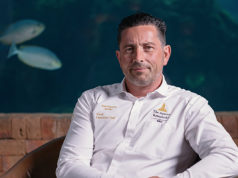Q: First of all, we’ve been hearing a lot of good things about Labyrinth and its huge success over the last year. Congratulations on becoming one of the most unique up-and-coming restaurants in Singapore. Would you mind telling us about how you came to create Labyrinth?
A: Labyrinth was born out of my love for local cuisine, as well as my belief that Singaporean cuisine in this day and age is not just limited to local street food but also dishes from all around the world. I myself grew up in Singapore in the 1980s and 1990s on burgers, sushi, hotdogs, pastas, etc. I created Labyrinth to be a creative think tank that has no creative boundaries and one that leverages on my palate as a Singaporean, infusing an element of fun, surprise and culture into my creations. Modern Singaporean Cuisine has been around for over 10 years but no one has attempted to push the boundaries of Singaporean cuisine to its extreme.
Q: Your story of banker-turned-chef is also very interesting. Care to tell us what drove you to make the shift? And what was the defining point where you realized your heart was in the culinary arts instead of finance?
A: I have always loved cooking, studying food science and putting my creativity to the test. Working in a corporate job does not give me the room to let my creativity grow beyond the four walls of the office and it was very stifling. Also, cooking for others allows me to derive a direct sense of self-fulfilment and seeing others enjoy my creations makes me feel happy that I am able to influence others in a very real way. The defining point was when I took up my first apprenticeship in a fine dining restaurant and despite the verbal and sometimes physical abuse, I realised that I really liked the environment better than being in an office and, as time went on, I knew that my passion to be in the F&B industry trumped that of being in finance.
Q: Tell us a little bit about the concept of Labyrinth and how its highly creative fusion cuisines set it apart from the rest.
A: Labyrinth’s name itself has a dual connotation: Firstly, it’s a gastronomical maze, which is why we serve only prix-fixe menus. Secondly, the “Lab” in Labyrinth also signifies our intention to be a centre of culinary innovation, not just a mere restaurant. At Labyrinth, we differentiate ourselves by striking a fine balance between traditional and modern. The foundation of our food is very traditional – from the ingredients we use in our sauces to the fundamental techniques that go into their creation. The modern aspect comes into play towards the end of each dish’s preparation, where we alter certain textures or deliver a visual deception to our customers. We use a myriad of cooking techniques, new and old, and the only guideline we abide by is: always select the technique that works best for the ingredients and the concept of the dish as a whole.
Q: Our theme for this issue is centred on fusion cuisine. What is your take on this trend and its effect on demands from your guests?
A: I often hear people saying “fusion is confusion and there is no substance behind it”, but I disagree. At Labyrinth, we have proven that given enough research and development, without compromising quality for innovation, fusion can be tasty, fun and refined. I believe fusion and creativity are directly correlated and the biggest pitfall is not knowing what one wants from the end product as he or she goes through the creation process. Demands from guests are already very high given the level of competition amongst restaurants in Singapore, and we cannot afford to deliver something sub-par to our guests, or risk them drawing comparisons to hawker food at 1/10th the price!
Q: We’ve seen some very original and highly creative dishes coming from your kitchen. What are your inspirations for these outstanding creations?
A: Our inspirations come from all angles: from the way we see a single ingredient differently from the others, to the unique memories of eating a certain dish during our childhood. As a Singaporean growing up in this modern day and age, there are some dishes that are very close to my heart and those can inspire as well. I try to identify dishes that have absolutely no link with each other but share a very similar DNA, in order to create a new dish. The chilli crab ice-cream that Labyrinth is famous for was born out of this train of thought.
Q: We believe this fusion cuisine trend will go on for quite a long time. How do you manage to always dish out new and original dishes and keep your customers engaged in new culinary adventures each time they visit?
A: I believe that you cannot force creativity, inspirations come when you least expect them, and after that it is just a matter of persistence, questioning and never giving up to deliver the vision on a plate. We at Labyrinth focus on two concepts when creating a dish: A dish has to deliver a visual deception to customers and a flavour they can relate to that has nothing to do with its visual appearance. In this way, we keep customers engaged and wanting to see what tricks we have up our sleeves next.
Q: Can you share some of the most memorable reactions from guests to your dishes?
A: I used to serve normal chocolates to customers after the meal as a mignardise and most customers refused to believe that it was just chocolate! I had to remove it from our new menu as it was the most uninteresting dish.
Q: What are some of the core philosophies needed to run such a successful restaurant like Labyrinth?
A: Quality, consistency, innovation, respect and integrity.
Q: Region wise, what would you say is the strongest influence on your cooking techniques?
A: Hawkers and traditional Chinese chefs are the strongest influences as they hold the key to the knowledge of traditional ingredients, heat control and very traditional recipes done the old-school way.
Q: What would you say is the most challenging/ rewarding aspect of your endeavour right now?
A: The most challenging aspect is customers understanding what we do and why we do it. We do not aim, for example, to have the best chilli crab sauce in town. We do, however, aim to present a fairly authentic version of the chilli crab in a unique manner. We play with the textures, visuals and temperature and have done a refinement of its flavours, as the traditional version can sometimes come across as oily and heavy. The most rewarding aspect is to be able to build long-lasting relationships with our customers. Through those connections, we are able to obtain their valuable feedback, which enables us to grow alongside them and continually improve our product.
Q: What do you believe are some of the most fundamental things to remember when creating fusion or creatively demanding dishes?
A: Never ever compromise on the quality or flavours of the dish just for the sake of creativity. Always remember that as a chef, our creations have to form a bridge with customer expectations. There is no short cut to creating fusion-esque dishes. Pure hard work, technicality and research that goes beyond cooking is key.
Q: What is the single most complicated dish you’ve ever created?
A: Our signature chilli crab dish might look deceptively simple, but it took me four years to perfect the dish. Firstly I had to get the chilli crab sauce ice-cream right and then I had to play with the garnishes and accompaniments that go with the dish to resemble the traditional version once consumed.
Q: What advice would you give to budding chefs/restaurateurs looking to make their mark in the culinary world out there?
A: There is a big difference between being a good chef and being a chef running a business. The latter is more demanding and one will realise that running a restaurant involves a lot of other tasks other than just cooking and creating. There is nothing glamorous about running a restaurant, just pure perseverance and lack of sleep!
Q: Lastly, what do you like to do to unwind?
A: I love travelling, although I rarely get much time to travel these days. I also love dining out at other restaurants to get inspired by what other chefs are doing. There is so much we can learn from each other and no chef is ever perfect or can claim to know everything.
Pineapple Fried Rice
Turmeric Sabayon:
3 egg yolks
1tbsp sugar
1tbsp white wine
5g turmeric powder
1½tbsp fish sauce
200ml whipped cream
100ml water
1. Add turmeric powder and fish sauce to water and reduce over medium heat to form a paste
2. Whisk egg yolks, sugar and white wine until white and fluffy
3. Continue to whisk the mixture over a bain marie until mixture becomes thicker and slightly warm, add the turmeric paste and continue whisking until mixture becomes a thick custard
4. Whip the whipped cream to soft peak
5. Fold the turmeric custard into the whipped cream
Rice Crispy:
1 cup rice
2 cups water
1. Cook rice in a steamer
2. Roll out rice onto a baking tray and dehydrate for 5 hours at 50 degrees Celsius
3. Deep fry dehydrated rice
Pineapple Sorbet:
2 pieces of ripe pineapples
Sugar and sea salt to taste
1tbsp corn syrup
1. Chop pineapples into small dices
2. Blend chopped pineapples and add sugar and sea salt to taste
3. Sieve pineapple puree and mix in corn syrup
4. Place in an ice cream churner to churn into sorbet
Final presentation:
Pipe out three dollops of sabayon through a cream whipper, place rice crispy in the middle with coriander
Sponge and floss crackers around, place a quenelle of pineapple sorbet on top of the rice crispy
Garnish with some raisins and extra virgin olive oil





